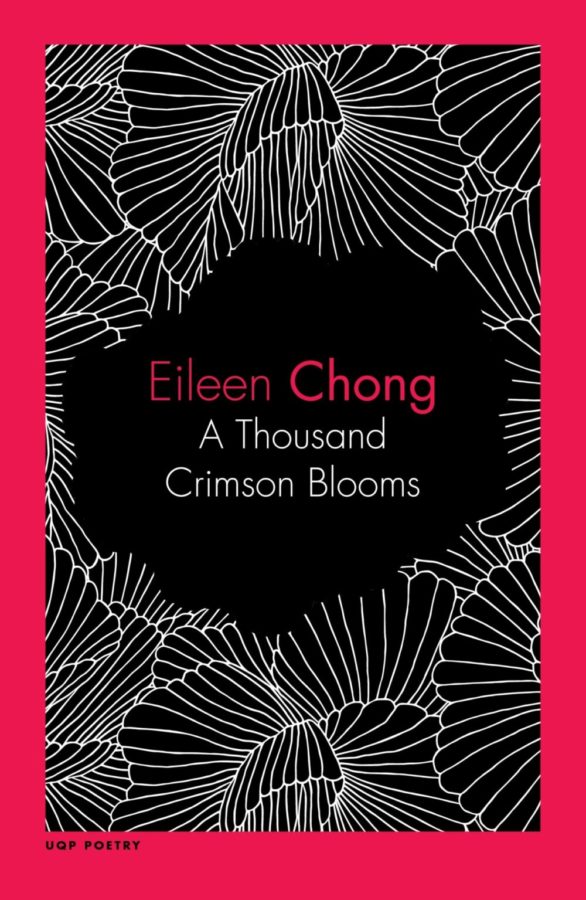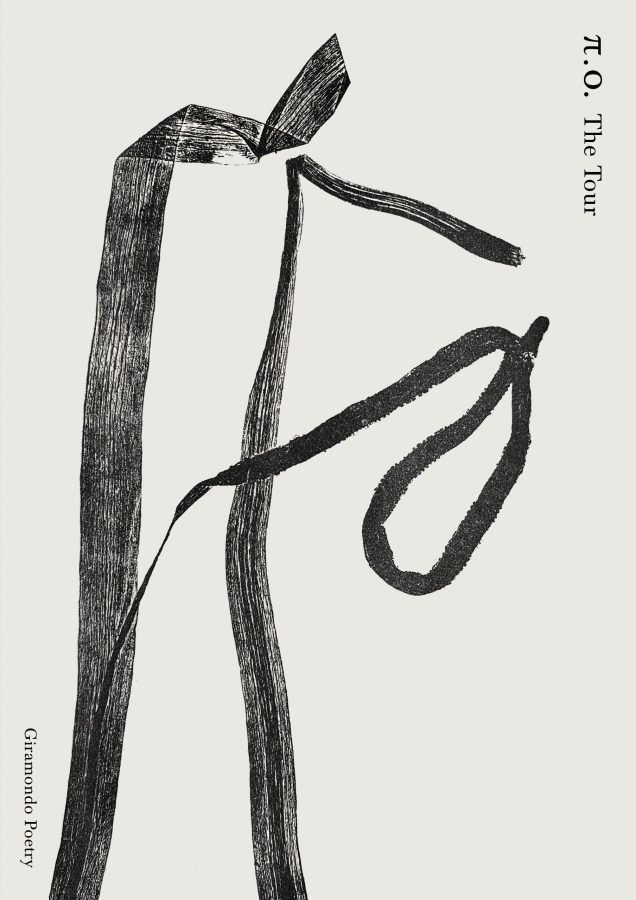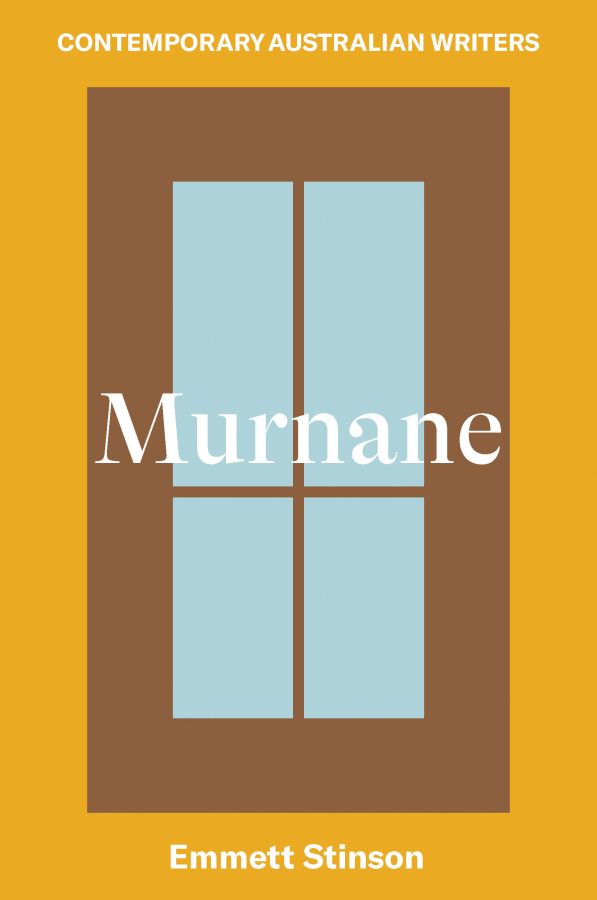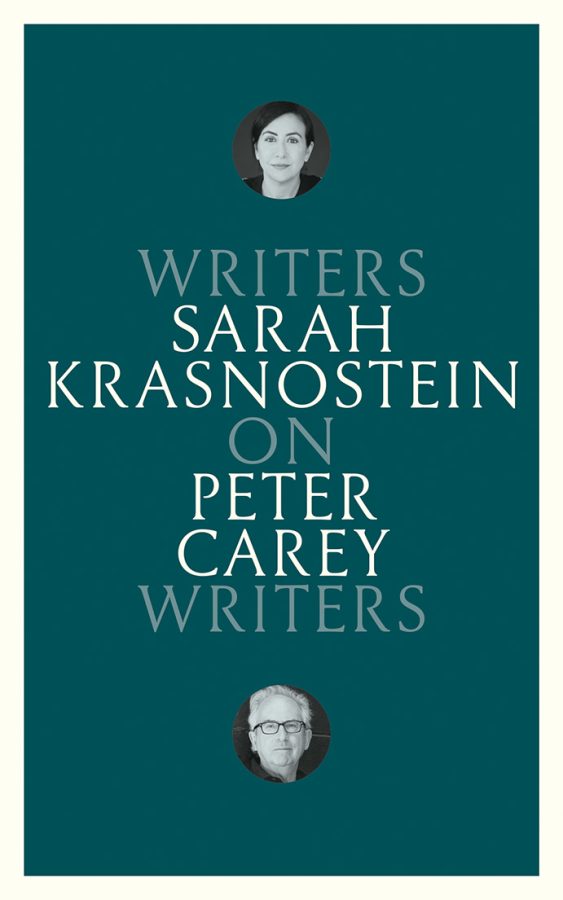After being cooped up for so long, and after enduring all the grief that comes with life, with none of the casual social support that one might feel in a non-pandemic year, I feel like a peeled boiled egg. All that grief and no casual gossip; no companionable wasted time walking through the city; no just being together. So much time to dwell, to ruminate, to marinate in this gothic circumstance. And what might otherwise have been? In the poem ‘Fortune-Telling’ in Eileen Chong’s A Thousand Crimson Blooms, I find diverging lines on a palm:
The life line bifurcated, the heart
line split.
A Thousand Crimson Blooms is a companion for enduring the barely bearable —for a grieving that reaches out, like raw worms, tender, craving connection. Even in the depths of grief and the existential loneliness that comes with grief, and even in the aftermath of trauma and abuse, Chong’s sensual language draws us back to the pleasures of living. The intensities and pleasures of living as embodied creatures of language and sensation desiring and deserving of pleasure —even as bodies in mourning, even as (or even, especially as) bodies who’ve survived violence. A Thousand Crimson Blooms is a collection that allows us to look at the sensuous world through a pinhole camera. The world outside, like a solar eclipse, too bright to face directly. Through the pinhole of these tightly burning poems, my raw nerves worm out.
The opening poem, ‘Singapore Koel’, is a microcosm of the collection in its intimacy, kinship, grief, intensity, and explorations of language and poetic form. The poem portrays the romance of friendship, and the depths of that love anchored in place, in light, in time—in a day that stretches out even as
We know our time will end […]
a parting, once more, of friends.
This couple ‘wander by winding waterways’, making sense, ‘measuring this parched earth’, sensing and measuring; in the same way, A Thousand Crimson Blooms moves between the intensity of the moment, and the aftermath, taking the time to take stock, reflect, luxuriate, grieve and rage.
The poem ‘Dog Meals’ opens with the line ‘The dead women always fed me’, a gothic tableau of a kitchen rich with food, and the anticipation of death:
thick wooden chopping blocks
where cleavers lay glistening—
bowls of sliced pork belly braised in soy,
trembling with fat; […] black fungus and beancurd skins.
Our speaker is left as sole witness to the funereal ‘procession of black ants crawling across the counter.’ ‘Sewing Daisies’ follows Mary Shelley’s Frankenstein in a romp through a graveyard:
I think of the flowers
that push up from burial mounds before grass even takes root.
Petals white as the knuckles of body-snatchers.
Chong’s gothic sensibilities turn to incantation as she casts a protective spell against violence in ‘The Wall’. The line ‘My roots will not slake your thirst’ carries a refusal of violent vampirism. In a similar vein the poem ‘Paper Tiger’ unravels the bravado of an abuser, and exposes him to the gaze of his intended prey:
To walk into a lair, knowing—
prey are attuned to every move.
With each muscular threat, fear ripples.
I know how to hide in the long grass.
Moving from proverb to present day, here the hypervigilance of the abuse survivor is reframed—not simply as a symptom, but as a strength. The paper tiger’s mythos is unravelling:
your skin is paper:
you are tearing at the seams.
The speaker finally finds her commanding voice, ending the poem in a clear directive: ‘Give it up. […] Stop hurting.’
Likewise, the poem ‘Rot’ invokes the image of the scavenger and the bird of prey, playing on the shared etymology of raptor, and of rape. The ‘I’ of the poem considers a ‘she’ who has been subjected to sexual violence, or to the threat of sexual violence. A ‘he’ enters the scene, a hunter – when finally the two pronouns, ‘her’ and ‘I’ blur together:
I went limp; I played dead. I meant to survive.
Pushed close to death in the moment of traumatic rupture, ‘Rot’ becomes a hex on perpetrators of violence. Their cruelty will blow back on them; fester inside them. A couplet closes the poem:
Predator, plunderer—your unending hunger;
your naked wattle, coated in carrion, will rot.
The near-rhyme and rhythm of the closing couplet gives finality and impact to the poem. A certain narrative justice: the raptor becomes a vulture, a forgotten and decaying body soaked in the violence they’ve wrought.
‘Griefs’ speaks to the embodiment of grief, pain, trauma, to the way the body carries grief and memory:
splinters raked in my palm,
which my skin would grow over
Emphasising bodily healing and resilience – whilst acknowledging the continued weight of traumatic memory, and the immanence of its resurgence. These poems have one foot in the past-present of the stinging moment, and one in a more reflective, analytic, future-present mode. ‘Griefs’ continues; asking, après-coup:
The past is called bygones:
by the by we are all gone
when we cross each other out.
Why do we recall what split us open?
Although the many different registers of grief permeate the collection, the sensuality of the language is steeped in the joys of an embodied life. A Thousand Crimson Blooms foregrounds sensuous language and its intimacy with our bodies; that sensuous experience is entangled in language. In ‘忍’ the etymology of the character 忍 is dramatised in a scene between intimates:
You whet a knife,
press the edge to my
heart […] draw blood
忍, (which can be translated as ‘to endure’) is de-composed into its composite parts: 刃 + 心 ; a blade, a heart, a drop of blood. And then she, the speaker of the poem, learns a new word, a Scots Gaelic word:
Today a new word: thole—to endure
what is barely bearable. I
will have to do this my entire life.
Making sense of experience through language, searching language for sense, is another central theme of this collection. This poem emphasises an interweaving of the body with language, of language with the body. An embodied relation, intuitive to our self-knowledge:
We know this word. […] I write it, red on white.
In the poem ‘Making Sense’ we are given a sort of ars poetica, one that opens in a pedagogical setting:
I tell my students:
poetry is a way to make sense
of what you fear.
The enjambment of the line leaves ‘poetry is a way to make sense’ standing alone and emphasised. This is the ethos behind these poems, trying to make sense of the senseless. senseless violence, senseless loss. And yet, this poem turns on irony. In the final stanza:
A girl at her desk begins a poem:
I dreamed everyone, even my own
mother, had forgotten my name—
‘Making Sense’ ends with an em dash— it is done yet continues on. The poem gestures toward a calculable sense of ‘making sense’, a sense that is teachable—and yet, the poem itself does not, and does not need to, resolve into a calculation—poetry remains incalculable. And this collection, after all named for a number (A Thousand Crimson Blooms), strives toward measure, calculation, making sense, and is nonetheless driven by the frisson of the in/calculable. Poems distill, even as they gesture toward whole worlds—worlds past, present, possible, and impossible. For the ‘I’ of these poems, finding the right way to articulate her experience—finding a way to make sense—is vital to her endurance. In ‘Woman, Crying’ the speaker recounts a scene where she was ‘unable to find the words’ to express her grief, her love, her loss. In the recounted moment, she shrinks herself:
I sat there, crying, while waitresses tiptoed
around me. One slipped me a napkin.
But she fantasises about making a scene, going back to that moment, to smash plates ‘to have stood up, thrown water / in his face’. Our speaker seeks justice. And throughout Chong’s poetics is a faith in poetry that thinks, that feels, that reflects, that yearns; a faith in the poem that might yet bend the world toward making sense —against senseless violence. Hers is poetry that thrives on the frayed edge of experience, whilst being anchored in an often formal poetics. In ‘Spring Festival’:
My husband reminds me I write poems
in threes: three lines, three pathways.
One for the old life, one for the new
and one for the hours I did not notice as they pass.
Here we encounter the intimacy of form in poetry. The intimacy of being read, closely. Making sense as finding a form for your own being. The form of a body, the form of a poem, of a relationship, of an exchange, of an entanglement. The form of knowledge, the form of feeling: a formal intimacy animates these poems. Many of these poems are crafted through traditional poetic forms: a crown of sonnets, a koel, a ghazal. By working with these poetic forms the poem forms a kinship with other sonnets, koels, or ghazals. Joining the flow of a lineage of the form—suturing to, and becoming the latest reincarnation of that form—a mutation and an heir. ‘Spring Festival’ closes:
I reach for paper and ink, I mark this page,
I seek an address, I want to be delivered home.
And where is home? Can we go there? Can ‘form’ be one answer to ‘home’? A way to be held? But even home is not a certainty. In ‘Prince of Wales Hospital, July 2018’:
You can go home
tomorrow. Can I? Go home? Tomorrow—
A significant number of these poems have epigraphs and dedications connecting them to other works, other writers, other people, others. The lyric ‘I’ speaks solo, whilst always reaching out for connection. Borrowed lines, epigraphs, and formal poetics show that the ‘I’ of these poems, even in her private intensities, is never truly alone. A chorus. A choral. These poems are intimate, sometimes lonely, but ultimately entangled with others. These poems invoke poets, poems, artists, and artworks. Named poets include, among others: Bella Li, Lucille Clifton, Andy Kissane, Jenny Xie, Zubair Ahmed, Maria Mercè Marçal, Bing Xin, Marie Howe, Brigit Pegeen Kelly, Elisaveta Bagryana, Forugh Farrokhzad, Judith Beveridge, and Ann Townsend. And so, although the poems in this collection are often about grief and the pain of embodied life, of cruel relationships and their aftermath— in form they offer a poetics that is alive, lively, optimistic. A sensual lens and also a deep kinship links these poems, as well as readers, in a web of sensual relation: we are not alone.
As I read this collection, Chong’s poetics began to seep out into my own life. I was feeling the potency of recognition—as a grieving reader, craving a tender connection, a companion for enduring the barely bearable. A Thousand Crimson Blooms is dedicated to the memory of Chong’s own recently passed grandmother. ‘The Call’ describes a phone call to a beloved grandmother; recollections of her cooking, her hands working with ‘gold rings on her fingers. Her lilac nails.’ For me, this poem evokes
my own, recently passed, beloved grandmother; although she wasn’t really a cook she did love to see her grandchildren fed and nourished, she treasured beautiful jewelry, and was always immaculately put together; she delighted in her own femininity, and looked beautiful in lilac. ‘The Call’ hits close to my heart:
I call my grandmother, and she remembers
my voice. She speaks my name, and it is full,
and whole. It rings in its clarity, its sounds
still formed by her lips.
The present tense of the narration slides into the memory of an everyday scene which will never again be repeated. My own grandmother’s phone manner was iconic among my cousins and siblings, and I reflected on this in my own eulogy for her. The poem ‘Ghazal for my Grandmother’, appeared online ahead of the collection, around the time of my own grandmother’s passing. For me, these two grandmothers are blazoned in this poem:
On the shelf, in your Chinese dress and wavy hair,
you cradled your young son. Not yet a grandmother—
I feel entangled with Chong in this poem (may I call you Eileen, just now?), in this love and grief—we two loving granddaughters:
This morning, when I was absent, you told the world
I, little bell, love you best. My heart is yours, grandmother.
In a kind of call and response that animates the collection, these poems ask how to endure the barely bearable? and they respond in kind—poems asking questions of poems, poems responding to poems (in epigraph, in formal poetics). After being cooped up for so long, with so much time to dwell, to ruminate, to marinate in this gothic circumstance; after all the grief that comes with life, we endure: 忍. And those who have done wrong will rot.
The eponymous poem ‘A Thousand Crimson Blooms’ opens with an epigraph from a poem by Bing Xin entreating children to notice the small things—and not to ‘trample [the] ‘tiny, yellow flower!’ Chong’s speaker entreats the children to create, to draw, to sculpt; before merging with the children, the tone taking a more sinister turn:
Let’s gouge out cavities with our fingers.
We are a hundred lidless eyes.
The poem reflects on the fate of the descendants of shattered inheritances:
You there—go out into the desert.
Come back when you’ve stopped weeping. […]
Our cut feet are a thousand crimson blooms.
It’s certain death for flowers without roots.
These poems together form the opposite of a flower without roots. Connected to the rich soil of experience, of kinship and communion with other poets and artists; claiming and exclaiming multiple lineages and inheritances; the grief and pain of a body that loves and eats and speaks.
And yet, amidst all this, we have voluptuous language entwined and inseparable from our sensuous being. The ‘I’ that inhabits A Thousand Crimson Blooms is flesh and blood. She is filled with the burning intensity of the moment. She is sensuous and she is fallible. She has regrets. She seeks justice. She will have revenge. She mourns and grieves. She eats. Mouths. Makes love. Searches for sense, and for a sense of home. A Thousand Crimson Blooms, these many tight and perfect poems burning with intensity and sensuality, calls to us home to our bodies as creatures of language and sensation desiring and deserving of pleasure.
Can I? Go home? Tomorrow—






